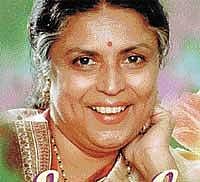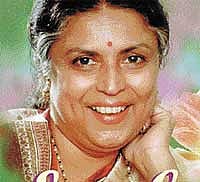

Just before her 73rd birthday on January 28, Suman Kalyanpur was honoured with the Lata Mangeshkar Award for her achievements — primarily in Hindi and Marathi but also in Gujarati, Kannada, Bengali, Punjabi, Maithili, Oriya, Rajasthani, Assamese, Bhojpuri and other languages including Chhatisgarhi. Her work spans across film music, devotional songs, ghazal, bhavgeet, folk and thumri.
Suman Kalyanpur leads a characteristically low-profile life in Pune today, but way back in an era when women mostly looked after the home and hearth, Kalyanpur became a career woman — out of choice and not compulsion. Married to a businessman when she was just four years into her career in 1958, the lady was recording till the late 90s, though her last film song came in Veerana in 1988.
Lata Mangeshkar as an entity, however, has loomed high in Kalyanpur’s career. She was said to be the first victim of the alleged Mangeshkar monopoly and her vocal similarity to Lata was said to be the raison d’etre for her professional undoing, for Kalyanpur with her tally of less than a 1000 recordings, did not reach anywhere as much as her talent deserved. What does she have to say about all this?
Kalyanpur says, smiling, “I like to think that whatever was in my destiny did come to me. I have even sung a duet with Lata-ji for Hemant Kumar in the film Chand. I never had any burning ambitions and still, a very huge percentage of my songs have become hits. Actually, I never had any specific intention of becoming a playback singer, and when I went to recordings, a family member would be with me, so that the wrong message wasn’t sent out! I never sang cabarets, mujras or songs with lyrics or situations that could have offended my family or in-laws. My skills and tastes were towards soft melodies. On the other hand, most of my songs were hits.”
Kalyanpur’s albums across languages continued in the 90s and included Sunehri Yaadein, a two-volume cover version of her own hits, most of which have been with Mohammed Rafi and Mukesh. Though not active as an artiste, she is still into riyaaz, listens to songs even today and admires A R Rahman. She also has kind words for technology in music that makes songs and singers sound better.
If music be her passion, Kalyanpur’s other interests include painting, embroidery, flower arrangement and gardening. Always fond of music and singing, she joined a music class in school with noted music director Yeshwant Deo as her teacher and later learnt music with her illustrious neighbours Keshavrao and Jyotsna Bhole. Small-time composer Mohammed Shafi gave her a break with ‘Koi pukare dheere se tujhe’ in Mangu in 1954, and the first hit she rendered was for ‘Meri preet mera pyar’ (Teerth-Yatra) in 1958.
Considered lucky in duets, come Rafi, Mukesh, Kishore, Manna Dey, Hemant Kumar or Talat Mahmood, Kalyanpur says that it was a misconception that she had only a few solos. In Marathi of course, Suman Kalyanpur has sung over a 100 timeless songs (mostly solos) in films and outside.
It was a dazzling 40 years-plus career that began in 1954 with the crème-de-la-crème including ‘Are sansaar sansaaar’, ‘Dev mazhaa vithu savalaa’, ‘Jagi jyaas koni nahin’, ‘Jithe sagara dharani milte’ and of course her anthem ‘Keshavaa Madhavaa’. The Hindi aces include ‘Dil ek mandir hai’, ‘Na tum hamein jaano’, ‘Ke jaan chali jaaye’, ‘Na na karte pyar’ and ‘Mere mehboob na jaa’.
The Lata Mangeshkar Award is the latest in a long line of honours and distinctions for her work across Hindi, Marathi, Gujarati, Punjabi and Bhojpuri. But Suman Kalyanpur asks, “Which musical artiste can ever be truly satisfied? Can you ever reach perfection or complete satisfaction?”
